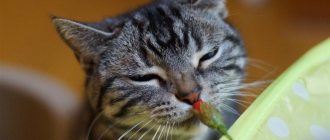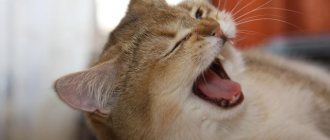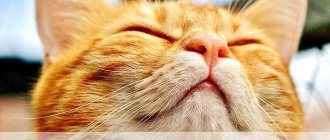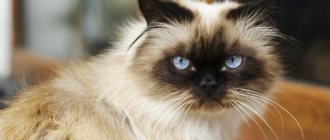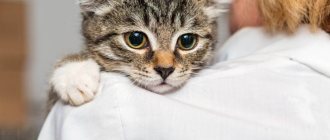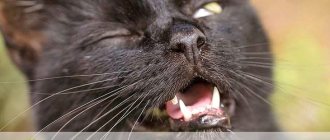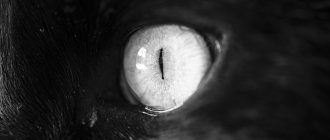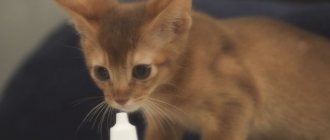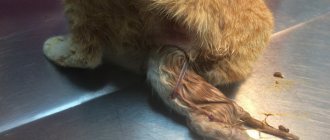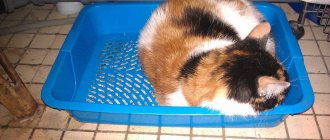The causes of sneezing in a cat can be caused by the entry into the nasal passages of various irritating particles and substances, foreign bodies, as well as bacteria, viruses and allergens that cause various diseases.
Sneezing itself is one of the unconditioned reflexes aimed at protecting the body, necessary for quickly eliminating pathological irritants from the nasal passages.
Domestic cats are capable of sneezing just like humans. A one-time sneeze should not cause concern to the owner, but a systematically repeated reflex can cause the development of serious pathological processes.
It is important to understand when sneezing is normal and when to seek help from your veterinarian for help and advice.
When is it normal for a cat to sneeze?
The reflex act of sharply inhaling deeply and exhaling forcefully through the nasal passages is called sneezing. During the process of the unconditioned reflex, various muscle groups are involved in order to carry out the strongest possible release of air from the deep parts of the lungs to cleanse the mucous membranes of unnecessary particles and irritating components. Unlike dogs, a cat can sneeze multiple times at once.
In order to clear its nasal passages, the cat actively takes a deep breath. All particles that were in the nasal passages are expelled by sneezing. Sneezing is normal and is characterized by several sets of 2-3 active sneezes. If accompanying symptoms occur, such as a runny nose, active discharge of mucous exudate from the nasal passages, lacrimation and swelling of the nose, you should consider visiting a veterinarian.
It is not too difficult to distinguish a normal condition from a pathological one. An attentive owner always notices changes in the pet’s condition in a timely manner.
A cat that sneezes from time to time and does not have parallel symptoms is absolutely healthy. The cause of sneezing can be not only dust, but also various aerosols, for example, air freshener.
The signs that appear in parallel when sneezing should alert the cat owner. Acute diseases are characterized by a specific reflex of clearing the nasal passages, loss of appetite or complete refusal to feed, lethargy and apathy. And pathological processes are accompanied by a runny nose and sudden discharge of mucous exudate.
An animal may actively sneeze when the mucous membranes are irritated by aerosols, tobacco smoke, or perfumes. At the same time, the cat does not change at all in its behavior, it is active, healthy, and does not lose its appetite. The sneezing is short, single.
Pathological causes of cat sneezing
Among the factors that provoke sneezing in a cat are a number of pathological ones. Before starting therapy, the doctor always conducts diagnostic tests to find out the cause of sneezing.
The main pathological causes of sneezing in cats are:
- Allergic type reactions. When the mucous membranes are irritated by allergens, frequent sneezing occurs. The cause of such an allergic condition can be various household chemicals, particles of which float in the air, detergents, oils and scented candles, and air fresheners.
- Colds. The cause of a cold is most often hypothermia of the body and a decrease in immune strength. In addition to sneezing, the cat has a runny nose and an increase in body temperature.
- Infectious lesions. Various fungal, bacterial and viral infections often affect the animal's respiratory tract. There is also discharge from the eyes, increased body temperature, and a severe cough.
- Helminthiases. Some types of worms can affect the respiratory tract. Settling in the respiratory organs, helminthiases are characterized by rapid breathing, runny nose, attacks of nausea and vomiting. Against the background of long-term infection with worms, the animal loses weight, and exhaustion of the body may occur. All helminthiases, in the absence of timely treatment, lead to the development of serious changes in the body, the main of which is a decrease in the body’s immune forces.
What to do
Since there are many reasons why a cat sneezes so much, which is unusual, treatment also varies. Antibiotics, antivirals, eye/ear drops, etc. are usually the primary treatment for a cat that has an upper respiratory tract infection. If your cat has a fever, your veterinarian may also prescribe antipyretics. In the meantime, you should make sure your cat eats and drinks enough.
Inflammatory conditions such as rhinitis and sinusitis require proper diagnosis. First, a professional veterinarian will perform a rhinoscopy to confirm whether your cat suffers from these diseases. However, in the meantime, broad-spectrum antibiotics and conservative treatment such as nutritional support will certainly help.
Allergic conditions, whether in humans or cats, are usually incurable. Thus, the only way to prevent exacerbation of a cat’s disease is conservative treatment.
For chronic diseases such as chronic rhinitis, there are no specific and guaranteed treatments for cats. However, you should do everything you can to relieve your cat's symptoms.
Dangerous reasons why a cat may sneeze
Pathological processes occurring in the body and characterized by sneezing can be extremely dangerous for the body. It is necessary to urgently seek help from a veterinary hospital if signs such as:
- sneezing accompanied by bloody discharge;
- nasal discharge when sneezing, characterized by the appearance of thick snot or pus;
- open-mouth breathing accompanied by sneezing;
- the presence of symptoms other than severe sneezing and nasal discharge.
The reason that the animal sneezes frequently and heavily, as well as other symptoms, may be:
- Foreign objects in the nasal passages or even in the esophagus . Most pets are extremely curious and can actively explore the world around them. Eating or inhaling small particles can cause blockage. Therefore, the reflex of clearing the nasal passages will be accompanied by heavy breathing.
- Formation of polyps in the nasal passages . The presence of benign growths or cystic neoplasms leads to constant irritation of the mucous membranes when inhaling air, so the cat may suffer from chronic runny nose and periodic sneezing.
- Development of bronchial asthma. Pets can suffer from a dangerous chronic disease, just like people. During an attack, the animal becomes lethargic, begins to sneeze, wheezing is heard and the visible mucous membranes become pale.
- Malignant tumors in the respiratory tract. Cancer of the nasal passages is rarely diagnosed in domestic cats, but it does occur. As a rule, cats with short hair and those who have reached 10 years of age are susceptible to the pathological process. Dangerous signs of nasal cancer in a cat are increased lacrimation, decreased appetite, loss of smell, and sneezing with droplets of blood.
First aid for a sneezing cat
In the vast majority of cases, the cause of a sneeze in a cat is a common runny nose after hypothermia, due to a cold. At home, you can alleviate your pet's condition by rinsing the nasal passages. This procedure will help cleanse the mucous passages from possible allergens. In order to cleanse the nasal passages, it is recommended:
- Take the rinsing solution and warm it to room temperature. A saline solution sold in pharmacies for newborn babies is suitable.
- Draw the solution into a syringe with the needle previously removed, and using a towel to secure the cat on its side in a lying position, pour a little liquid into one, then into the other nostril.
- It is very important to take a short break before pouring the next portion of the solution. This is necessary so that the animal has time to get rid of the remains.
- At the end of the procedure of washing the nasal passages, you can blot your nose with a dry soft napkin and release the animal.
You can independently rinse your cat’s nasal passages with saline solution at home only if you have previously consulted with a veterinarian. The fact is that sneezing can be caused by a foreign body, and rinsing leads to the pushing of foreign particles into the deep parts of the respiratory system.
The best solution would be to take the animal to a veterinary hospital. The specialist will conduct a detailed examination and prescribe a series of studies to identify the main reason that provoked the development of a specific reflex for clearing the nasal passages.
Preventive measures
To minimize the risk of a hoarse cough in cats, you need to adhere to the following rules:
- promptly vaccinate the animal against infectious diseases;
- carry out regular treatments against helminths and skin parasites;
- brush the hair of representatives of long-haired breeds daily;
- periodically feed gels and pastes to remove hair from the stomach;
- prevent pets from hypothermia;
- strictly observe the rules of cat hygiene and ensure high-quality living conditions;
- Do not feed your cat raw river fish and tubular bones.
If, however, a situation arises in which the cat begins to cough, wheeze and cling to the floor, then you should immediately go to the veterinary clinic. Specialists will quickly find out the causes of these symptoms and provide qualified assistance.
